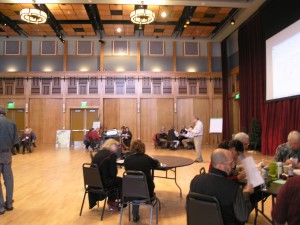
Strategy consultants Dave Mason and Jim Herman led Gould Hall workshop session at View on Wednesday. Photo by Dana Armington
The Common Ground Alliance (CGA), the Adirondack North Country Association (ANCA), and the Adirondack Part-ner-ship are currently conducting a series of two-day workshops titled, “Mapping the Future of the Adirondacks,” throughout the region.
A group of nearly forty community members from throughout the region, including business owners, representatives from non-profit agencies and town government, and Senator Betty Little, attended the latest workshop at Old Forge’s View on Tuesday and Wednesday, January 10 and 11.
Among the area representatives in attendance were CAP-21’s Nick Rose and Deb Carhart; APA Chairwoman Lani Ulrich (who is a core team member for the CGA); Town of Webb Councilwoman Kate Russell; Tug Hill Commission Executive Director, John Bartow; Community Bank Vice-President Barbara Criss; ANCA Executive Director Kate Fish; and Peggy O’Shea, President and CEO of the Community Foundation of Herkimer and Oneida Counties.
Also in attendance were Old Forge business owner, Kathy Rivet, and concerned Eagle Bay citizen, Deborah Elmer.
The pro bono project, led by retired strategy consultants Dave Mason and Jim Herman, was designed to stimulate new and creative thinking about the different challenges and opportunities the Adirondack Park is currently facing.
The workshops were designed to inspire discussions throughout the regional community regarding what needs to be done in the short and long terms to arrive at the most desirable outcome for all.
During the local workshop, participants were broken into groups to discuss and determine the levels of attainability as compared with the levels of desirability of six long-range potential scenarios.
Guests were asked where they see the Adirondack Park in 2037, twenty-five years now, and which, if any, was the best possible outcome for everyone.
The list of scenarios as presented were:
Scenario A: The Wild Park, outlined a recommitment to Article 14, “Forever Wild” and the spiritual and symbolic values to preserving wilderness areas in response to the homogenization and urbanization of the twenty-first century.
Scenario B: A Usable Park outlined the desire to focus efforts on creating the Adirondack Brand, which would rely heavily on twelve-month, indoor and outdoor recreation, tourism, and “made in the Adirondacks” manufacturing.
Scenario C: The Sustainable Life describes a healthy diverse economy that supports a healthy environment.
A sense of community is important here, living close to the land respectfully, not separately; living better without big growth.
Scenario D: Adirondack County describes a situation in which, by 2037, the Blue Line will be redefined, as its own county, thereby creating a single justice system, tourism office, and school district; as well as a singular, cohesive, park identity.
Scenario E: Focuses on self-reliance and practicality-driven solutions.
There is far less government because people no longer expect the government to come in and fix things, instead Towns and Villages successfully take responsibility.
Ultimately, some areas thrive where others will fail, just like the business world.
Scenario F: Adirondack State Forest is one that no one wanted to see happen.
According to the scenario, external conditions have overwhelmed the park, climate change has drastically altered ecosystems and winter recreation, and invasive species—including man—have destroyed the pristine nature of the park.
Of the scenarios, The Sustainable Life, was the most popular “what if” situation in each of the workshops conducted, and was found to be the most desirable and most attainable of the the six presented, according to Ulrich.
The Usable Park was also determined to be a popular subject, she said, with much discussion taking place in regards to how the two scenarios could be combined to generate the best possible outcome.
Herman and Mason saw The Usable Park scenario as one where every community within the Blue Line could participate to create a global marketing campaign, improve air and rail transport, and create continuing care retirement projects to help attract the retiring baby boomer generation.
To date, two-day workshops have also been held at Paul Smith’s College and the Chestertown Town Hall. Plans are currently in the works to host four-hour mini workshops in Saranac Lake that will be open to the public.
“The Mapping the Future of the Adirondacks workshop was enlightening—a unique structure for an age-old conversation about what the future could be for the Adirondacks,” said View’s Executive Director, Jennifer Potter-Hayes.
More information can be found online at www.adkfutures.org, or by contacting Dave Herman at (518) 524-1703.

